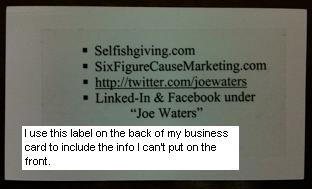Better Cause Marketing with the Lowly Business Card
 I hope you didn't give Chris Brogan your business card at SXSW this week. He didn't want it, and with good reason.
I hope you didn't give Chris Brogan your business card at SXSW this week. He didn't want it, and with good reason.
Unless you want to do business with me, don’t give me a business card. We both know how to reach each other, so unless one of us asks for one, let’s not hand them out. We tend to give out business cards because we’ve been taught this is what to do. It’s not. It’s the old way .... In the new way, you and I should only exchange cards if we’re looking to do future business. Otherwise? We roughly know how to reach each other, don’t we?
The crowd at SXSW is probably one of the most wired crowds around so Chris is right: business cards are unnecessary. But in many industries, including nonprofit, they're still more the norm because they serve a real purpose.
That doesn't mean I haven't tried to cut back on handing out business cards, or to be more strategic in how I use them. As Chris notes, business cards "just blast people with messages whenever WE need something."
Here's how I've tried to use mine to make better cause marketing connections.
No business card. When I'm the speaker at an event I never hand out business cards. They distract the audience from what I really want them to do: go to my blog, which I always talk about in my presentation. At my blog, people can find answers to their questions--without bombarding me with emails--and can connect with me six different ways. Besides, if they get home and can't remember my blog or can't figure out how to find me, including just doing a quick search on Boston cause marketers on Google, I'm not sure I want to talk to them anyway!
Their business card. I don't hand out business cards to everyone I meet, but I will for theirs. Not to track them down, mind you. I can figure that out. The card is a reminder, something to jot notes on. Nowadays I usually take a picture of the card with my iPhone and give it back (Evernote is a handy place to store these pictures as the text in them becomes searchable). A lot of these same people ask for my card in return. I redirect. "I'll email you my information." This allows me to better manage my initial communication with them. I'll send my contact info via email, but I'll also include links to a couple of relevant posts to read and then, of course, links to all my social media connections. This enhanced business card has a bigger networking punch.
Two-sided business card. My nonprofit limits what I can have printed on my business card. We have to use a standard format so I can't plug my blog, Twitter handle, Facebook, etc. So a while back I printed up labels for the back of my cards that included all this info. They work well, especially for people who aren't comfortable with technology and like to have something more traditional.
A word about etiquette. I feel like people share a tiny piece of themselves when they hand over their business cards. They're small, have semi-personal information and, if you're like me, you keep them close to your heart (in your shirt pocket!). The least we can do is show little a little class when we get a card or hand one out. I always present my card face-up and then flip it over so I can explain the additional info to her. When I get a business card, I just don't stuff it in my pocket. I look at it. Name, title, address, logo, etc. "When did you become a vice president?" "I grew up right near where your office is." "This is really nice card!" I want them to know that I'm interested and their business card has further piqued my curiosity.
If I have an idea I want to share with someone, I write it down on one of my business cards that is blank on the back. I hand them the card and say "Someone once said that if you can't write your idea on the back of a business card you don't have a clear idea. This is a good idea for you and I look forward to talking to you more about it."
My clear idea for you today is that business cards are a great tool to support your cause marketing work. But the key is to use them less like a bullhorn and more as a trip wire to trigger more productive conversations and ultimately better partnerships.

